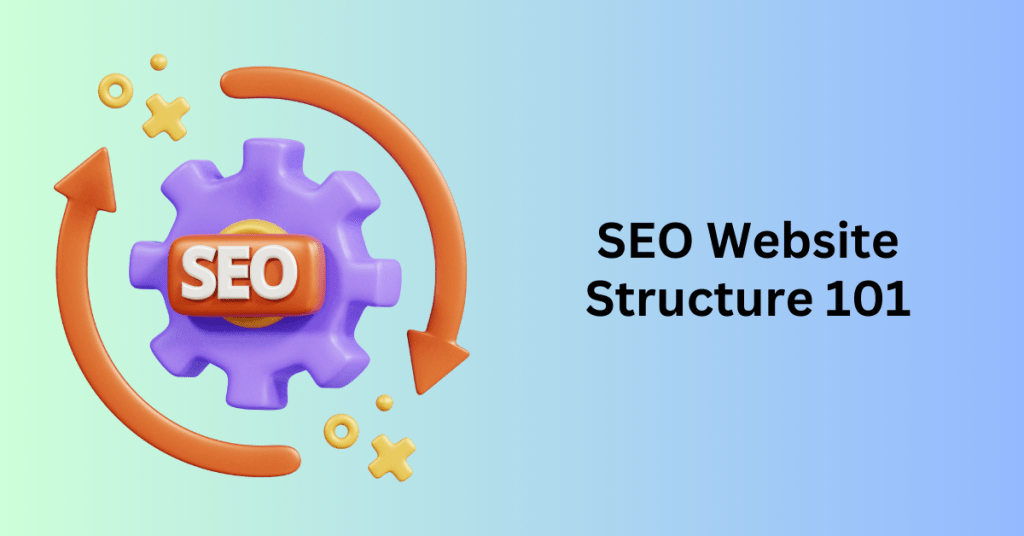Website structure is an essential component of any effective search engine optimization (SEO) strategy. It serves as a roadmap, guiding search engines like Google in understanding the hierarchy and importance of the content on your site.
A well-designed website architecture directly influences which webpages or pieces of content achieve higher rankings on search engine results pages (SERPs). While it’s common to focus on elements like keywords, linking strategies, and content quality when developing your SEO plan, if your website fails to clearly communicate its priorities to search engines, all those efforts may ultimately be in vain.
Whether you are launching a new website or optimizing an existing one, understanding the principles of website structure for SEO is crucial.
Get a WordPress Optimized Hosting Plan for Better SEO
SEO Website Structure 101

Website structure, also known as website architecture, defines the way in which your website’s pages are organized and connected. It serves as the backbone for all visual elements and content that you want to display.
The architecture of a website typically begins with the homepage, which acts as the central hub from which users can access various pages and subcategories.
For effective search engine optimization (SEO), it’s crucial to design your website architecture in a manner that enhances its discoverability by search engines like Google. Much like an organized bookshelf allows you to quickly find your favourite book, a well-structured website helps search engines easily locate and index your content.
But why is this important? Consider your website as a lively gathering, and you, the host, are responsible for ensuring that your guests—both users and search engines—can navigate seamlessly from the entrance to the dining area without feeling lost in a labyrinth of rooms. When search engines can effortlessly traverse your site, they are more likely to reward you with higher rankings in search results.
Website structure can generally be categorized as either flat or deep. A flat website architecture prioritizes delivering information to users with minimal clicks, promoting efficiency in navigation. In contrast, a deep architecture allows for the creation of detailed topic pages, guiding users along longer paths to uncover information.
Most contemporary websites favor a flat structure, which makes important pages readily accessible and facilitates easier navigation for users while simplifying the crawling process for search engines.
Different Website Structure Model
Delving deeper into website architecture, we can identify four primary models:
- Hierarchical Model: This structure consists of main parent pages that branch out into more specific child pages, creating a clear hierarchy of information.
- Sequential Model: In this arrangement, users are led through a predefined sequence of pages, moving either forward or backwards in a logical order.
- Matrix Model: This type presents users with multiple topic groups, granting them the freedom to choose their own navigation path rather than being restricted to a linear or hierarchical flow.
- Database Model: This architecture relies heavily on metadata and information architecture principles, allowing users to create a personalized browsing experience. While more complex to implement, it offers greater flexibility and customization for users.
By understanding and implementing a thoughtful website architecture, you can greatly enhance the user experience while optimizing your site for search engines, ultimately leading to improved visibility and engagement.
Why SEO Website Structure is Important

A well-organized site structure is a critical component for achieving success in search engine optimization (SEO). Here’s why it’s essential:
Serves as a Navigation Guide for Search Engines
A thoughtfully designed website structure enhances navigation for Google bots, allowing them to crawl and index your site more effectively. By implementing an intuitive layout and a strong internal linking strategy, you can help search engine bots understand which pages hold the most significance. A well-organized sitemap further clarifies the relationship between different pages, improving your site’s overall SEO performance.
Boosts Organic Traffic
When your website is optimized for SEO, it typically achieves higher rankings on search engine results pages (SERPs). This increased visibility can lead to a surge in organic traffic. A structured site that provides relevant and easily accessible content not only keeps visitors engaged but also reduces bounce rates. This engagement can create a positive feedback loop, enhancing other SEO benefits.
Influences the Display of Sitelinks
Sitelinks are subpage links that Google displays beneath your main URL in search results. The configuration of your internal links and overall site structure plays a vital role in determining which subpages are chosen for these sitelinks. Generally, Google prioritizes pages linked from primary navigation menus and tabs, making their visibility a direct result of effective site architecture.
Enhances User Experience
A user-friendly website is key to retaining visitors. A clear and logical site structure allows users to navigate effortlessly between pages, helping them find exactly what they need without frustration. Conversely, a disorganized website can lead to confusion, driving users away to competitors. This not only increases bounce rates but can also negatively impact conversions.
Increases User Engagement and Conversions
When users can easily navigate your site and locate what they’re seeking, they are more likely to convert from casual visitors to paying customers. An intuitive design minimizes the cognitive load on users, making the path to conversion straightforward and clear. A robust website architecture supports this seamless experience, encouraging visitors to stay longer and interact more.
Aids in Content Planning
Your site architecture serves as a framework for both web design and content strategy. By establishing a solid structure optimized for SEO, you can plan the placement of your content more effectively. This includes creating a wireframe—a basic layout of your site—based on the defined structure. Once the wireframe is in place, you can strategically position category pages, lead pages, keywords, and other essential content.
Facilitates Scalability
A well-thought-out website architecture simplifies the process of optimization and scaling as your business expands. You’ll have a clearer understanding of where to add new pages, which outdated content to remove, and how to restructure existing pages. This adaptability is crucial for SEO, as the landscape is continuously evolving. For instance, keywords that are relevant today may not hold the same value in the future. A streamlined site structure allows for easier adjustments to accommodate new keywords and better target your audience.
By prioritizing a strong website structure, you lay the groundwork for enhanced SEO performance, improved user experiences, and ultimately, greater success in achieving your online goals.
Get a WordPress Optimized Hosting Plan for Better SEO
How to Organize an SEO Website Structure

Let’s explore the essential steps involved in structuring your website effectively:
1. Develop an SEO-Friendly URL Structure
Begin by securing a domain name if you haven’t done so already. Next, turn your attention to the structure of your URLs, as they play a crucial role in SEO. Well-crafted URLs help search engine crawlers understand your site’s content and facilitate better indexing. To enhance your chances of ranking higher in Google searches, ensure that your primary categories and product pages are easily accessible.
Each page should have a unique URL—avoid situations where a single page is reachable through multiple addresses. Aim for URLs that:
- Clearly describe the content users can expect to find
- Incorporate relevant keywords where appropriate
- Remain concise and easy to read
- Use hyphens instead of underscores to separate words
- Are written in lower case
- Avoid unnecessary words or characters
- Are designed to accommodate future content expansions
For a deeper understanding of optimizing your URL structure for SEO, consider insights from resources like Search Engine Journal.
2. Analyze Your Competitors’ SEO Website Structure
Creating a robust website structure can be challenging, especially for larger sites. To navigate this process effectively, research high-ranking competitors to understand their organizational strategies. Utilize SEO tools to identify their best-performing sections and seek ways to provide an even better user experience.
If you’re operating in a competitive niche, examining industry giants can also offer valuable insights. For instance, while you might not have as extensive a catalog as Amazon, you can analyze their successful strategies and adapt similar approaches for your own site.
3. Establish a Clear SEO Website Structure
Your website’s hierarchy dictates the arrangement of its pages. Prioritize essential pages such as product listings, services, pricing, and contact forms, as these typically serve as the entry points for users. Incorporate keyword research into this planning process to strategically position primary keywords on high-traffic pages, while placing secondary keywords within relevant product or service pages.
Information architecture is also key; it outlines how relevant information will be distributed throughout your site. A pyramid structure is common, where the most critical content resides on the homepage, with other information branching out to secondary pages. This hierarchy helps search engines assess the importance of each page, influencing their rankings on search engine results pages (SERPs). Avoid scenarios where less critical pages outrank your main offerings.
4. Streamline Your Website Navigation
Navigation is a vital component of your site structure and significantly impacts user experience. Implementing a top-level navigation menu is essential. Regardless of your website’s complexity, a simple, user-friendly navigation bar positioned just below the header will facilitate user engagement.
Avoid cluttering your website with unnecessary pages; this can confuse visitors and hinder their ability to find key revenue-driving pages. Make critical information like product features and pricing readily accessible, possibly integrating additional details lower on the same page or on subpages. A streamlined navigation system allows search engine crawlers to navigate your site more effectively, ensuring that key pages are prioritized in search rankings. For e-commerce websites, employing faceted navigation (or filtering) can enhance user experience significantly.
5. Implement Breadcrumbs
Breadcrumbs are a crucial yet often overlooked element of both navigation and SEO. These navigational aids display a trail that users can follow, making it easier to navigate your site. For example, a breadcrumb trail might look like this: Home > Services > Digital Marketing.
Utilizing breadcrumbs encourages logical thinking in your site design, fostering a clear and focused structure that benefits both users and search engines. A refined architecture enhances crawling capabilities and helps search engines display appropriate sitelinks when users search for specific keywords.
6. Ensure Security and a Positive User Experience
Both search engines and users prioritize security. Websites using HTTPS protocols are favoured by Google, and users often look for HTTPS at the beginning of URLs to avoid scams. Ensure your site is secured with HTTPS.
Additionally, your website structure should enable users to navigate to their desired content with minimal clicks. Maintain consistency in design and layout across pages to provide a cohesive experience. If you’re new to your industry, consider emulating the navigation and layout of established competitors to create a sense of familiarity for visitors.
7. Create a Comprehensive Internal Linking Strategy
Developing a robust internal linking structure is vital for enhancing your SEO efforts. By establishing a web of links between your pages, you help search engines navigate your site more efficiently, improving your rankings.
Use descriptive anchor text for internal links, directing users from one article or product to related content. Keeping users engaged on your site for longer periods increases the likelihood of converting them into leads or customers.
By following these steps, you can create a well-structured website that not only enhances user experience but also improves your SEO performance, ultimately leading to greater visibility and success online.
Get a WordPress Optimized Hosting Plan for Better SEO
Audit your SEO Website Structure
Just as regular health check-ups are essential for maintaining your well-being, auditing your website’s SEO architecture is crucial for ensuring its optimal performance and visibility. But how do you effectively conduct this audit?
Start by leveraging a variety of powerful tools designed to give you insight into your website’s inner workings. Options like Google Search Console and Screaming Frog allow you to explore your site’s structure in detail. These tools will scan your entire website and generate comprehensive reports highlighting what’s functioning well and what requires attention. They can help you identify issues such as broken links, duplicate content, and other common SEO pitfalls, ensuring that nothing goes unnoticed.
Interpreting Your Audit Results
Once the audit is complete and you have your results in hand, the next step is to analyze these findings. An SEO audit is only valuable if it leads to actionable insights. Here’s how to make the most of your results:
- Understand the Data: Take the time to thoroughly review the audit report. Identify which areas of your website are performing well and which ones need improvement.
- Identify Gaps: Look for discrepancies between your site’s current performance and your SEO goals. Are there critical pages missing? Is there content that needs to be optimized? Recognizing these gaps is vital for your next steps.
- Prioritize Changes: Not all issues are created equal. Determine which problems are most pressing and will have the most significant impact on your site’s SEO performance. Focus on high-priority items first, such as fixing broken links or optimizing high-traffic pages.
- Implement Changes: Develop an action plan to address the identified issues. This may involve updating content, restructuring your site’s architecture, or enhancing internal linking strategies.
- Monitor Progress: After implementing changes, continue to track your website’s performance using the same tools. Regularly monitoring your SEO metrics will help you determine if your adjustments have been effective.
- Iterate and Improve: SEO is not a one-time task; it’s an ongoing process. Regular audits should become a standard practice to ensure your website remains competitive and aligned with current best practices.
By conducting a thorough SEO architecture audit and taking meaningful action based on your findings, you can significantly enhance your website’s performance and visibility in search engine results. This proactive approach not only boosts your site’s SEO health but also helps you stay ahead in the ever-evolving digital landscape.
Final thoughts: How To Create a SEO Website Structure
Website architecture is crucial for SEO and user experience. A well-organized structure helps search engines crawl and understand your site effectively. This leads to better indexing and linking to relevant pages, enhancing visibility in search results and improving ranking potential.
For users, a strong website architecture facilitates easy navigation and access to information. When visitors can quickly find what they need, they are more likely to stay longer on your site. This results in increased engagement and lower bounce rates.
In summary, a solid site structure is vital for optimizing search engine performance and providing a positive user experience. Ultimately, it drives more traffic and conversions to your website.


